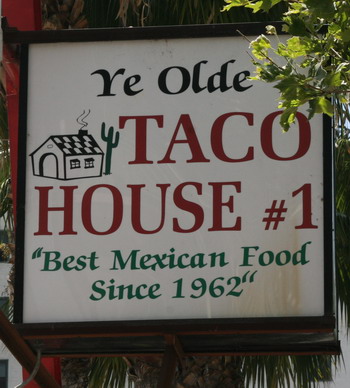Ye Olde Mispronunciation

Pictured above is the sign for a Mexican restaurant called “Ye Olde Taco House #1,” found via a Google search. The sign says that the joint has been around since 1962, so it’s unlikely that it has its origins in Medieval Europe, despite the “Ye Olde” in its name. Nonetheless, the owners of Ye Olde Taco House #1 decided that faux Old English gave their restaurant an extra bit of class, perhaps. Who knows. Regardless, it’s safe to assume that there’s nothing from Ye Olde Taco House #1 that is actually from the Middle Ages.
You knew that already, but when you read the paragraph above, you probably made a mistake. Most likely, you pronounced “Ye Olde Taco House #1” (in your head or audibly, I can’t say) by starting off with the sound that the letter “Y” typically makes. “Ye,” as in “hear ye, hear ye,” for example. That’s wrong. “Ye” not only means “the,” but in this context, should also be pronounced that way, too.
To understand why we have to start with a thorn. Not the thorn that grows on the stem of a rose, but one that looks like this: þ. (That should look like a p but with the loop in the middle of an extending-upward vertical line. If you can’t see it, click here for an image.) The thorn is a letter, or, more accurately, was a letter — it’s now mostly defunct, to the chagrin of top-hat-wearing and tongue-sticking-out emoticon lovers alike. It’s from Old English and while it looks like a lowercase p, it makes the sound of a “th.” So in Old English, “þe” was pronounced, “the.” Over the years, the alphabet changed and the thorn turned into the two-letter combo (called a “digraph”) “th.”
But before we went from “þ” to “th,” for reasons unclear, we stopped off at the letter “y.” Jeopardy champ Ken Jennings and prolific YouTuber MinutePhysics attribute the change to typesetters who found themselves needing to make the “th” sound but without a thorn and, for some reason, thought the “y” was a better fit than the “p.” Wikipedia attributes the change to scribal abbreviations in the 1500s — the thorn’s abbreviation was similar to that of the y, and the two merged over time, basically due to sloppy or lazy handwriting. Wikipedia further notes that when printers entered the picture, they, like Jennings and MinutePhysics suggest, merged the thorn and the y permanently.
Regardless, you should call the Mexican place noted above “The Old Taco House Number One” if you ever call it to place a takeout order.
Bonus Fact: The thorn is characterized as “mostly defunct” above. But it’s not “totally” defunct; that’s because it’s still in use by about 300,000 people. The thorn is part of the Icelandic language, which most people in Iceland speak even today. The thorn itself is rarely used but, as Wikipedia notes, written Icelandic hasn’t changed much over the last thousand years, so it still appears here and there. Those who speak Icelandic today, therefore, are able to understand texts from long, long ago (“with some effort,” the Wikipedia entry tosses in as a caveat).
From the Archives: Feed the Pig: Why do we call them piggy banks? It has more to do with “ye olde” than it does with actual pigs.
Related: “Ye Olde Weird But True,” a Nat Geo trivia book. For kids ages 8 to 12. The book says, “in the Middle Ages, only rich people ate white bread.” I don’t know if that’s true (and I haven’t looked into it), but I either way, they did not call it “ye olde white bread.”
